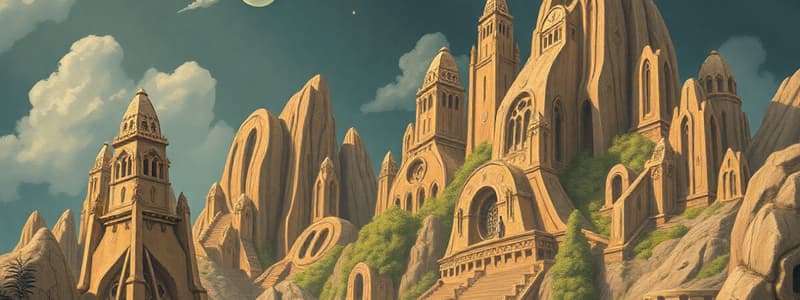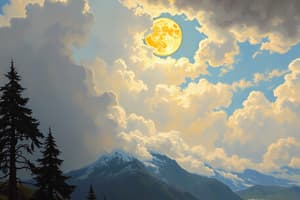Podcast
Questions and Answers
What process led to the formation of larger bodies in the early solar system?
What process led to the formation of larger bodies in the early solar system?
- Condensation of gas molecules
- Evaporation of water ice
- Magnetic attraction of particles
- Accretion of dust-size particles (correct)
Which of the following planets is classified as a terrestrial planet?
Which of the following planets is classified as a terrestrial planet?
- Neptune
- Saturn
- Earth (correct)
- Jupiter
What key characteristic must a celestial body possess to be classified as a planet?
What key characteristic must a celestial body possess to be classified as a planet?
- It must have cleared its orbit of other objects (correct)
- It must have rings
- It must have moons
- It must be visible from Earth
Which layer of Earth is located at the boundary known as the Mohorovicic discontinuity?
Which layer of Earth is located at the boundary known as the Mohorovicic discontinuity?
What is the primary component contributing to the Earth's chemical composition?
What is the primary component contributing to the Earth's chemical composition?
What characteristic distinguishes Jovian planets from terrestrial planets?
What characteristic distinguishes Jovian planets from terrestrial planets?
Which process involves the heating and segregation of the Earth into layers?
Which process involves the heating and segregation of the Earth into layers?
Who first calculated Earth's circumference?
Who first calculated Earth's circumference?
What is the primary focus of physical geology?
What is the primary focus of physical geology?
Which branch of geology specifically studies volcanoes and volcanic activity?
Which branch of geology specifically studies volcanoes and volcanic activity?
What is a key concept associated with catastrophism in geology?
What is a key concept associated with catastrophism in geology?
Which of the following branches of geology deals with the determination of the Earth's age?
Which of the following branches of geology deals with the determination of the Earth's age?
What does the term 'geochemistry' refer to in the context of geology?
What does the term 'geochemistry' refer to in the context of geology?
Which aspect is emphasized in the discipline of geology regarding the study of natural systems?
Which aspect is emphasized in the discipline of geology regarding the study of natural systems?
In the study of geological processes, what does 'geomorphology' focus on?
In the study of geological processes, what does 'geomorphology' focus on?
Which branch of geology is concerned with the geology of celestial bodies?
Which branch of geology is concerned with the geology of celestial bodies?
What is the density of the Earth as stated?
What is the density of the Earth as stated?
Which of the following correctly describes the continental crust?
Which of the following correctly describes the continental crust?
What is an orogen?
What is an orogen?
Which feature is NOT included in the categories of Earth’s large scale features?
Which feature is NOT included in the categories of Earth’s large scale features?
Which statement accurately describes cratons?
Which statement accurately describes cratons?
What does the principle of uniformitarianism suggest about geologic processes?
What does the principle of uniformitarianism suggest about geologic processes?
Which event is NOT classified as a geohazard?
Which event is NOT classified as a geohazard?
Who proposed the Big Bang Theory in the 1920s?
Who proposed the Big Bang Theory in the 1920s?
According to the Nebular Hypothesis, the solar system formed from what?
According to the Nebular Hypothesis, the solar system formed from what?
Which celestial body accounts for the majority of the solar system's mass?
Which celestial body accounts for the majority of the solar system's mass?
What phenomenon supports the Big Bang Theory through the observation of galaxies moving away from each other?
What phenomenon supports the Big Bang Theory through the observation of galaxies moving away from each other?
What is a common characteristic of geohazards?
What is a common characteristic of geohazards?
What did Edwin Hubble contribute to the understanding of the universe?
What did Edwin Hubble contribute to the understanding of the universe?
Flashcards are hidden until you start studying
Study Notes
Introduction to Geology
- Geology is the study of the Earth's origin, history, composition, structures, physical properties, and the process that shapes it.
- It also explores resources that can be obtained from the Earth.
- "Geo" means Earth and "logos" means study.
Main Branches of Geology
- Physical Geology: Focuses on the materials and processes that affect the Earth.
- Volcanology - study of volcanoes and their activity
- Seismology - study of earthquakes and the earth's mechanics
- Mineralogy - study of minerals and their properties
- Petrology - study of rocks and their formation conditions
- Geomorphology - study of landforms and their shaping processes
- Geophysics - physics of the Earth and its space environment
- Geochemistry - study of the Earth's chemical composition and processes
- Planetary Geology - focuses on the geology of celestial bodies
- Environmental Geology - uses geological information for environmental management
- Engineering Geology - applies geological knowledge to engineering problems
- Mining Geology - focuses on mining applications
- Petroleum Geology - applies geological knowledge to searching for hydrocarbons
- Historical Geology: Studies the Earth's origin and evolution over time.
- Paleontology - study of prehistoric life and fossil remains
- Stratigraphy - study of rock layers and their layering (stratification)
- Geochronology - determines the age of the Earth and its materials
Basic Concepts in the History of Geology
- Catastrophism: Proposed by Baron Georges Cuvier, this theory suggests that worldwide catastrophes are the agents of change that alter the Earth's physical features over time.
- Uniformitarianism: Proposed by James Hutton, this theory states that "The present is the key to the past." It emphasizes that the Earth is continuously modified by geological processes that have always operated throughout time.
Geohazards
- Geohazards are earth processes that cause life and property loss.
- Flooding
- Earthquakes
- Volcanic activity
- Landslides
- Mudflows
Geologists at Work
- Geologists play a crucial role in daily life, mineral deposit identification, and resource exploration.
Formation of the Universe: Big Bang Theory
- The Big Bang Theory proposes that about 13.7 billion years ago, all matter and energy compressed into an incomprehensibly hot and dense state.
- This compressed state began to expand and cool, flinging matter in all directions.
- It was proposed by Georges Lemaître and justified by Edwin Hubble's observations of the expanding Universe.
Formation of the Solar System: Nebular Hypothesis
- The Nebular Hypothesis suggests that the solar system evolved from a giant rotating cloud of dust and gas called a nebula.
- This cloud contracted due to gravity, forming a rotating disk.
- Collisions caused dust particles to coalesce into asteroid-sized bodies.
- Cooling led to the condensation of rocky and metallic material into solid particles.
Composition of the Solar System by Mass
- Sun: 99.85%
- Jupiter: 0.10%
- All other planets: 0.04%
- Comets: 0.01%
- Satellites and rings: 0.00%
- Asteroids: 0.00%
- Meteoroids and dust: 0.0000001%
The Solar System
- Inner or terrestrial planets:
- Mercury, Venus, Earth, Mars
- Rocky composition: primarily silicate rocks and metals (Si, Fe, O)
- Giant or Jovian planets:
- Jupiter, Saturn, Uranus, Neptune
- Lack solid surfaces: exist in gaseous or liquid forms
- Composition: light elements (H, He, Ar, C, O, Ni)
- Pluto: Neither terrestrial nor Jovian; similar to the icy satellites of Jovian planets.
Planets: Characteristics
- To qualify as a planet, a celestial body must:
- Be in orbit around the Sun.
- Be large enough to take on a nearly round shape.
- Have cleared its orbit of other objects.
Earth's Formation
- Earth began as a "dust ball" formed by gravity (accretion) from the nebular gas and dust.
- It heated up (heating) and eventually separated into layers (differentiation) as it cooled.
- Denser elements (e.g., iron) sank, while lighter ones floated to the surface, creating a differentiated Earth.
Earth's Layers
- Discontinuities/Boundaries:
- Mohorovicic - separates the crust from the mantle.
- Gutenberg - separates the core from the mantle.
- Lehmann - separates the outer core from the inner core.
Earth's Vital Statistics
- Chemical Composition: 34.6% Iron, 29.5% Oxygen, 15.2% Silicon, 12.7% Magnesium.
- Shape: Flattened at the poles and bulging at the equator.
- Size:
- Equatorial Radius: 6378 km
- Polar Radius: 6357 km
- Equatorial Circumference: 40076 km
- Polar Circumference: 40008 km
- Volume: 260,000,000,000 cu.miles
- Density: 5.52 g/cm3
External Features of the Earth
- Lithosphere: Made up of moderately rigid plates (oceanic or continental lithosphere) that consist of 7 major plates and several smaller plates.
Earth's Large Scale Features
- Continents:
- Continental Crust: Thick (30-60 km), old (250-4000 m.y.), and light.
- Does not subduct.
- Largest features:
- Mountain Belts (Orogen) - proposed by L.Kober in 1921.
- Orogen: An extensive belt of rocks deformed by orogeny (mountain building), associated with plutonic and metamorphic rocks.
- Examples: Andes, Alps, Himalayas, Urals, Appalachians, Caledonian, and NA Cordillera.
- Cratons: "kratos" meaning strength (Greek). Proposed by L.Kober as kratogen in 1921.
- Old and stable interior parts of the continent, relatively undisturbed.
- Include the shield, which is free from sedimentary cover.
- Mountain Belts (Orogen) - proposed by L.Kober in 1921.
- Continental Crust: Thick (30-60 km), old (250-4000 m.y.), and light.
- Ocean Basins: Thin, geologically young (less than 200 m.y.).
Key Figures in Earth Science
- Baron Georges Cuvier: Proposed the theory of Catastrophism.
- James Hutton: Proposed the theory of Uniformitarianism.
- L. Kober: Proposed the terms "orogen" and "kratogen" in 1921.
- Georges Lemâitre: Proposed the Big Bang Theory.
- Edwin Hubble: Provided observational evidence supporting the Big Bang Theory.
- Immanuel Kant and Pierre Simon de Laplace: Proposed the Nebular Hypothesis.
Studying That Suits You
Use AI to generate personalized quizzes and flashcards to suit your learning preferences.



